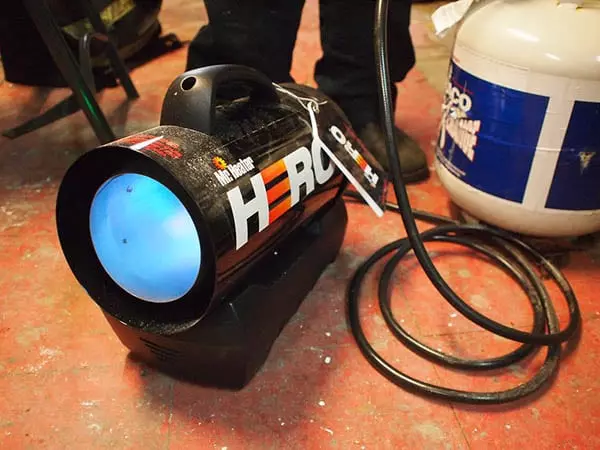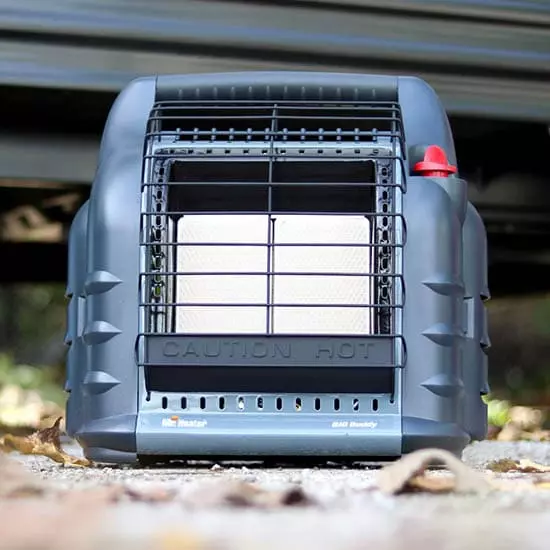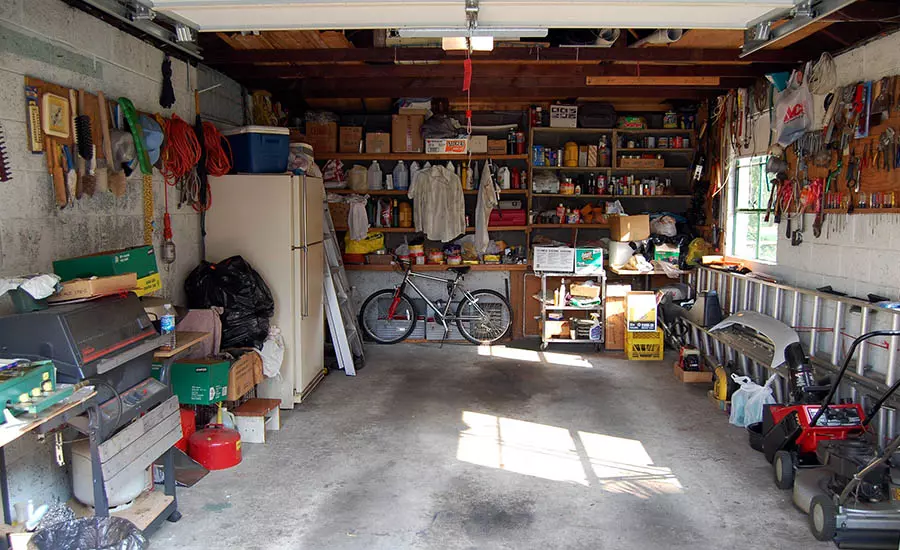How can you heat a garage without insulation? What’s the best way to do it? Is it possible to heat effectively? And if yes, how?
Generally speaking, garages can get uncomfortably cold in the wintertime. Especially when your garage is without insulation.
Entering a cold garage is and having no option to heat it effectively is like jumping into cold water - it’s just uncomfortable and everyone hates it.
Especially if you have a garage woodworking shop (or similar), it adds a lot of enjoyment if you can heat your space whenever you like.
Without insulation, you’d rather avoid your garage in the wintertime.
I’m an electrical engineer and I’ve spent countless hours in the freezing cold woodworking shop at my parent’s house.
Here’s are 5 effective ways to heat a garage without insulation.
How to heat a garage without insulation
First, there’s no free lunch: You either have to spend money on insulation or pay for heat. Later, I’ll show you a simple strategy to not waste money on heating in the long run.
1. Overhead tube heater
An effective way to heat a garage without insulation is to install an overhead infrared tube heater.
Because they work with infrared radiation, these big heaters don’t heat the air, they heat objects.
Intuitively, that makes a lot of sense: A garage without insulation oftentimes has air gaps (below doors, under the roof).
Heating not the air, but objects makes sure that the heat you perceive is not affected by air exchange.
What I like about them is that if you open a door, most of the heat will not disappear instantly, because it is not stored in the air, but in objects.
However:
Without proper insulation, the heat will eventually disappear. Additionally, heating with an infrared tube heater is an expensive decision.
The upfront cost of getting one of these is well above a thousand dollars.
Additionally, they’ll raise your electricity bill significantly.
That’s why I would avoid getting one of them, although they are a practical way to heat your garage without insulation.
2. Install a wood stove
Another option would be to install a wood stove in your garage. Because your garage is without insulation, you need a powerful heating system to compensate for that.
Wood stoves have the heating power you need.
Additionally, having one in your garage will add manly, cabin-like flair in your garage. It’ll feel like you are surviving in a deep forest.
Wood stoves are a perfect choice if you don’t have access to electricity in your garage.
However:
Wood stoves require wood to run. If you hate chopping wood, skip this section.
Also, firing up a wood stove requires effort. If you want to heat your garage only occasionally, it might not be worth the trouble.
For keeping your garage warm, you first need to collect wood, then light a fire, wait for the wood to burn down and then collect the ashes.
Whereas you can just switch on and off electric space heaters.
If you’re a passionate wood-chopper and you like saving money (wood is mostly cheaper than electricity) then a stove is for you.
For installing a wood stove in your garage, you’d also need to install an exhaust vent.
But it’s surprising how inexpensively you can do this:
You can get a wood stove kit for under 100$.
3. Torpedo propane heater
Torpedo propane heaters can heat your uninsulated garage incredibly well. They force out hot air with high velocity (like a jet engine) which in turn heats up your garage.
And they look pretty cool. To me, a torpedo heater is the ultimate man’s toy.
 credit: Becky Stern
credit: Becky Stern
It’s hot, dangerous, and blasts fire.
Mostly they run on propane gas, but there are also kerosene versions of them.
Propane is, however, cheaper and safer indoors.
Because torpedo heaters start heating immediately (compared to a wood stove), they are great if you’re just occasionally in your garage.
Also, they are inexpensive for the power they can deliver.
With torpedo heaters, you should be careful about safety aspects. They can ignite stuff.
So, don’t use them if you are woodworking and producing dust which could light up in a fire.
At least, always have them at a safe distance.
Here’s the torpedo heater I recommend:
Just make sure you have a safe place for your torpedo heater. Because they blast so much air, they can even slide around if you put them on a slippery floor.
So, make sure you have a torpedo-safe spot in your garage before getting one.
A garage forum member writes
“My garage is a little bigger than yours, but it’s insulated (not that great at that) and my 70,000 BTU radiant torpedo burns me out of there.”
sixball - member of garagejournal
A 20 lb propane tank will last you 65 hours at low settings and 24 hours on full heat.
If you’re spending half an hour in your garage daily that’s nearly a two month’s supply on full heat.
4. Propane heater
Regular propane heaters (not the torpedos) are very durable as well. If you use one with a 20lb propane tank, it’ll last for months.
Because regular indoor propane heaters don’t force out hot air, they are more efficient than torpedos.
In contrast to torpedo heaters, indoor propane heaters are absolutely quiet. So, they’re useful if you need to concentrate.
However, they don’t heat a garage as quickly.
I’d recommend
- A torpedo heater if you need the whole garage hot ( quickly)
- A regular indoor propane heater if you want to keep warm & cozy and have time for the garage to heat up (you prefer silence and safety).
Still, regular propane heaters are effective heaters for your garage. Because your garage is without insulation, you just need to give them a few minutes to heat.
Here’s my recommendation:

The best thing about the Mr. Heater propane heater is that it is very safe to run indoors. It has automatic tip-over protection for example.
So, if it falls over, it’ll automatically shut off.
And you can place them anywhere you like, even on your workbench.
A torpedo heater needs much more care and sensitivity to be safe.
5. Add basic insulation to your garage
Even though the 4 different heater types I’ve just shown you are great for keeping your garage warm, you’ll waste energy as long as your garage is not insulated.
The final step (after getting one of the heaters) is to insulate your garage.
Here’s a strategy:
- Buy a propane heater and see how well it heats your garage.
- Meanwhile, save money and spend it on basic insulation.
- Over time, you’ll have a heated & insulated garage.
Don’t worry about spending money on insulation! You’ll easily earn it back in the long run because it will save you a significant amount of heating costs.
Where to insulate a garage first?
The biggest heat sink of a garage is a bare metal roof. Because metal conducts heat well, and hot air rises, a metal roof will “wick away” the heat like a dry sponge would wick away water.
A garage roof without insulation is nearly always a heat-sink.
Therefore, I’d start with adding insulation material to your roof.
I’m not an insulation expert, I’m an electrical engineer. But I’m sure that taping rigid foam to your ceiling will already add a lot to the insulation of your garage.
Don’t worry about how it looks. Using tape is fine (I mean, it’s just a garage).
So, if you have a metal roof, start with insulating it first.
Then, look out for air gaps. You can find them below the doors and maybe below the roof.
Each garage is unique, so I can’t tell you where exactly to look out for air gaps. However, nearly always there are gaps below the doors.
“If you fail to fill those air gaps, you’ll still be wasting a lot of heat.”
thespruce- Garage Insulation Guide
You’ll definitely need to insulate these door gaps. To do so, get inexpensive door insulation tape and tape it below your door. They block air the air transfer and help a lot with insulation.
With an insulated roof and air-gap-free doors, you’re a big step ahead! I’d bet you’d save 50% on heating cost then.
Conclusion - How to heat a garage without insulation
Answer: The best way to heat a garage without insulation is to get powerful, indoor safe propane heaters. Over time, you can then slowly add insulation to your garage: Insulate your ceiling with rigid foam and close air gaps under garage doors with door insulation tape.
In the long run, an insulated garage always beats a garage without insulation in terms of heating cost and comfort.
And insulated garages don’t only keep you warm in the wintertime, they also stay cool in the summer.
So, you can benefit from them all year round.
Attributions: title image by Wang
